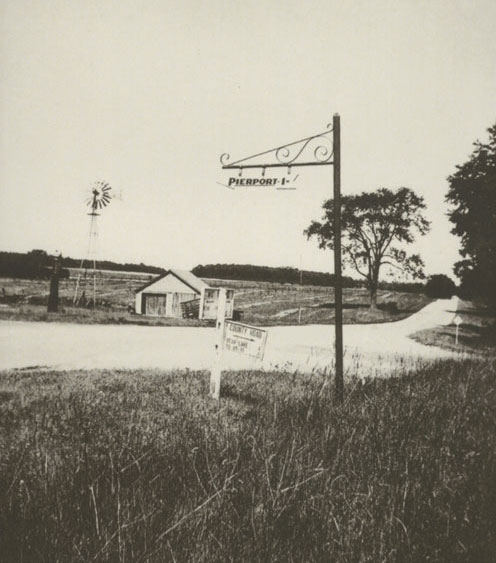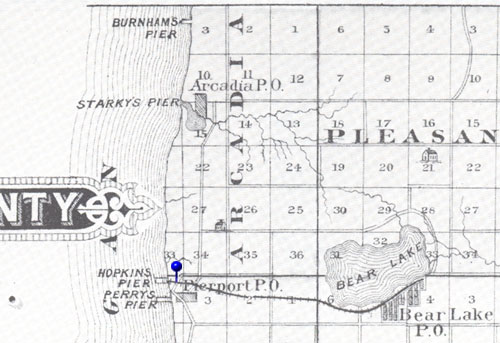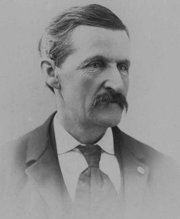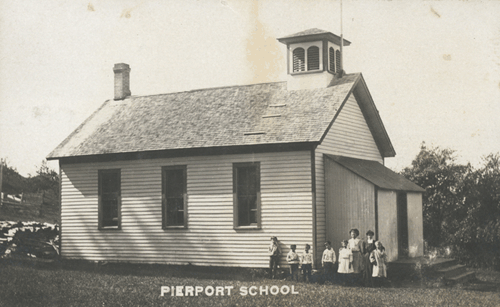Pierport, Michigan
Next | Previous | Return to Start
|
In 1866, the Turnersport Pier Co. built a pier to ship wood products from what would become Pierport. So began Turnersport, which was renamed Pierport in 1871. Pierport developed into a thriving village with general stores, a school, post office, hotel, blacksmith shops, a sawmill, a stave factory, two piers, a railway connection to Bear Lake, homes, and farms. |
|
|
Where Is Pierport?"Formerly Turnersport, a small place in Onekama Township, Michigan, 14 miles north of Manistee, on the shore of Lake Michigan. The country around is heavily timbered, principally with hard wood. The principal shipments consist of tan bark, cord wood, railroad ties, and potatoes. Fruit also is cultivated. It has a semi-weekly mail. Jeremiah James, postmaster." |
|
|
|
|
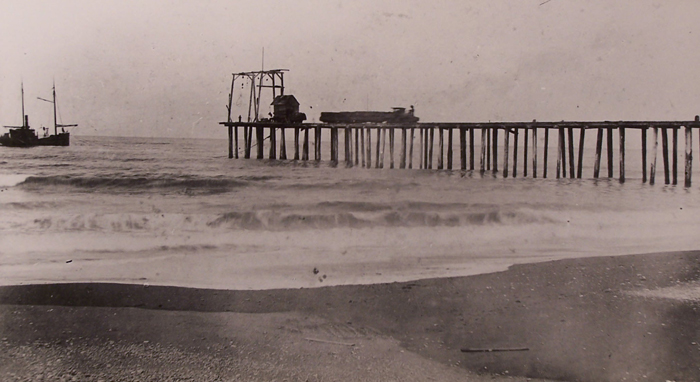 |
|
| A Pier at Pierport Note the small locomotive on the pier pulling cars loaded with wood products. The crane at the end of the pier is ready to load waiting ship, and the weather is cooperating. The photo is undated, but this is probably the Hopkins pier, which was built in 1879. |
|
The Turnersport Pier CompanyIn 1855, Alexander Gibson, Edward Murray, and others purchased land about 14 miles north of Manistee, Michigan from Bear Lake west to the Lake Michigan shore. Gibson and Murray were investors in Turner and Eckels' property development, and in 1866, Turner and Eckels built a pier on the shore of Lake Michigan about 14 miles north of Manistee. As the Turnersport Pier Company, they planned to ship wood products to ports along Lake Michigan's shore. The Turnersport settlement initially consisted of the pier and three shanties. In 1868, the Turnersport Post Office opened with postmaster Charles Eckel. The Turnersport settlement consisted of the pier, three shanties, and the new post office. In the same year, Turner and Eckels mortgaged their land to borrow $4,500 at $3 per acre. In 1870, the Turner and Eckels mortgage foreclosed. C. W. Perry, who loaned them the money, took possession of the Turnersport Pier Company property. |
|
Early PierportIn 1871, C. W. Perry moved to Turnersport and used a log building close to the pier to run his shipping business and open a general store. In 1872, the settlement's name was changed to Pierport. In 1873, Perry hired three men -- Henry Clay Matteson, Hiram Chapin, and O'Rorke -- to build a general store on the north side of what is now 13 Mile. It was a 25 ft. by 64 ft. wood frame building with two floors. The Pierport Post Office was located in the Perry store, and Perry and his bride would live on the second floor until their house was built. However, before the Perrys could move in, their baby was stillborn. |
|
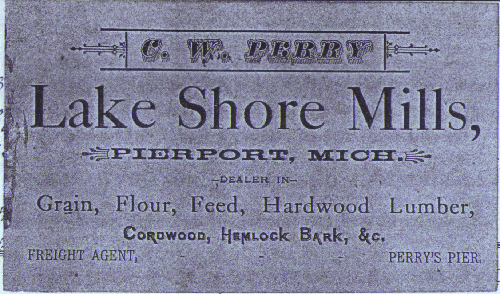 |
|
The Settlement GrowsThe settlement continued to grow with the developing lumbering and shipping business. Sometime in the 1870s, C. W. Perry built an elegant house on Knob Hill, an elevation that provided a magnificent view of Lake Michigan. Hiram Pratt built a residence called "Lake House." C. W. Perry built a lodging establishment called "Commercial House" and hired caretaker Charles Fowler. In 1873, telegraph poles were placed in Pierport. The telegraph line eventually stretched east to Bear Lake and north to Frankfort. The telegraph instruments (probably the key, sounder, and batteries) were installed at Perry's store early in 1875. The New Pierport SchoolIn 1874, C. W. Perry donated land and materials for a school. H. C. Matteson, M. Swiger, Crabb, Keil, and Patch built a one-room, wood-frame school to accommodate the growing community's children. The school was 20 x 32 ft. with an 11 ft. ceiling. At the first school board meeting, members voted to raise $100 for a teacher for four months, two in the winter and two in the summer, and to raise a $30 contingency fund. Each scholar was expected to provide 1/4 cord of maple wood to help pay for the school. School began January 11, 1875. |
|
|
The RailwayIn 1875, when Pierport had about 40 inhabitants, the Hopkins brothers of Bear Lake began construction on a tram railway that would be used to haul lumber from Pierport to Bear Lake about five miles away and return with freight. The tram's rails were made of maple with steel strapping, and the car was pulled by horses. The Bear Lake Tram Railway began operation in 1876. In its first week of operation, the car came off the track twice, when the driver was unable to control the speed down the hill east of Pierport. In 1882, the tram was replaced by the Bear Lake and Eastern Railway, a narrow gauge railway with steel rails. The company had a locomotive and forty cars, so the railway could handle far more lumber and fruit products than the old one-horse tram. The Hopkins brothers, for example, purchased $100,000 worth of forest products from local farmers in the first year of the railway's operation. |
See Also: Early Arcadia Area Schools |
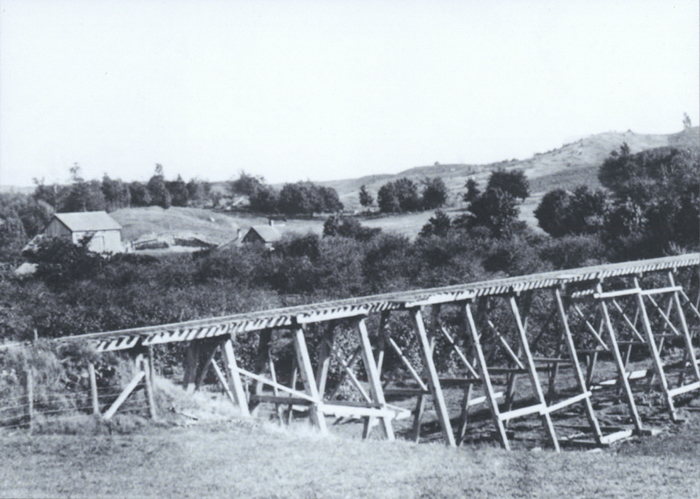 |
|
| The Bear Lake and Eastern Railway Trestle near Pierport The trestle flattened out the area so problematic for the tram railway. It was located on the H. C. Matteson farm, which later became the Harmer farm. More People and BusinessesIn 1876, a Methodist group was organized and held services in the school house. In 1886, they built the Methodist Episcopal Church. Also in 1876, George Dwyer built a sawmill. The sawmill became C. W. Perry's property when Dwyer could not pay the $3,000 he owed for materials. In 1877, Stevens & Mise built a stave factory in Pierport. By 1878, the stave factory was producing 100 barrels and 25,000 staves per day. According to App. Smith of the Manistee Times, "Last season [1877] over 1,000 cords of bark were shipped from this point, which Mr. C. W. Perry bought from farmers and others at about an average price of $3.50 per cord." Also in 1878, C. W. Perry built a grist mill in Pierport. The grist mill was just east of the Perry sawmill. The Hopkins PierIn 1879, the Hopkins pier was built at Pierport. The first vessel to arrive at the new pier was the Frankie Wilcox, a 230 ton wooden scow-schooner that sank later the same year 3.5 miles north of Manistee. Also in 1879, the Hopkins store opened at the pier, and Hopkins filed additional plats on the north side of town. The Thriving 1880sIn 1881, Pierport had 175 residents. After the Stevens & Mise stave factory burned down, E. R. Stillman built another stave factory. Seymour Calkins, one of Arcadia's early settlers, bought an interest in the stave factory and formed the firm Stillman and Calkins as the proprietors of the Pierport Stave Factory. C. W. Perry built a new home. J. E. Bodwell moved to Pierport for the Bear Lake Pier Company and started a general merchandise business. "Formerly known as Perry's Pier, ... 16 miles north of Manistee court house, with which it has daily stage communication; fare $1.25." A stage also runs to Frankfort, 19 miles north, twice a week; fare, $1.25. Lumber, cord-wood, tan-bark, flour, and fruit are the leading shipments. Bank at Manistee. Telegraph, Western Union. Charles W. Perry, postmaster. "Business Directory Bear Lake Pier Co, general store and pier. Conklin Charles, blacksmith. Elliott Samuel, carpenter. Ellis S H, livery. Estes G K, propr Commercial Hotel. Hayden James M, blacksmith. Miller J N, physician. Muhle Lewis, shoemaker. Perry Charles W, blacksmith and wagonmaker. Perry G W & Co, General Store, Lumber and Flour Mnfr, Steamboat Agt, and Pier Propr. Power W D, wagonmaker. Pratt Hiram, hotel propr. Wasson Thomas M, carpenter. Wilson J F, plasterer" Pierport thrived socially too. In the 1880s, the Lake Shore Lodge of Good Templars was organized with 55 charter members. A young people's literary society had 40 members and reportedly flourished. In 1885, Pierport's population was 225. Arcadia's population was 200. Burnham's population was 250. |
|
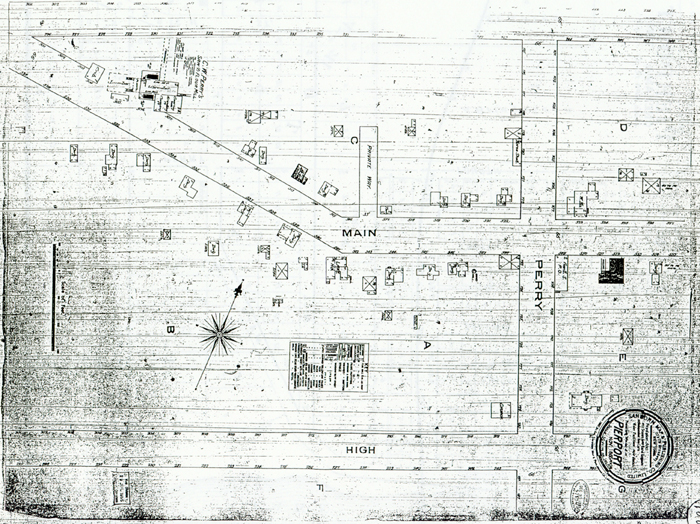 |
|
| 1885 Pierport Map This map shows the buildings along Main Street. The general store was at the southeast corner of Perry and Main Streets Farther up the street to the west was Pratt's Lake House, and the Perry sawmill and flour mill. Click here for another map showing more of the settlement including a newer subdivision north of the railway. "...Pierport has steam power flour and feed mills, a saw mill, stave and windmill factory. Wood, lumber, tan bark, potatoes and fruit are the leadning shipments. Daily stage communication with Manistee, Frankfort, and intermediate points. Population 225. Bank at Manistee. Tel., W. U. Charles W. Perry, postmaster. "Bear Lake Pier Co. Beswetherick, sawyer and filer. Conklin Charles, blacksmith. Conklin J M, wagonmaker. Eagan Evril, miller. Elliott Samuel, carpenter. Elliott Thomas, carpenter. Fowler Charles A, propr Commercial hotel. Hayden James M, blacksmith. Hayden James M, windmill mnfr. James David A, livery. Miller J N, physician. Muhle Lewis, shoemaker. Nesson N, mason. Perry Charles W, Lumber, Flour Mnfr, Grain Dealer and Railroad Agent. Perry C W & Co, general store. Pratt Hiram, hotel propr. Shafer George, mason. Stillman & Calkins, stave mnfrs." |
|
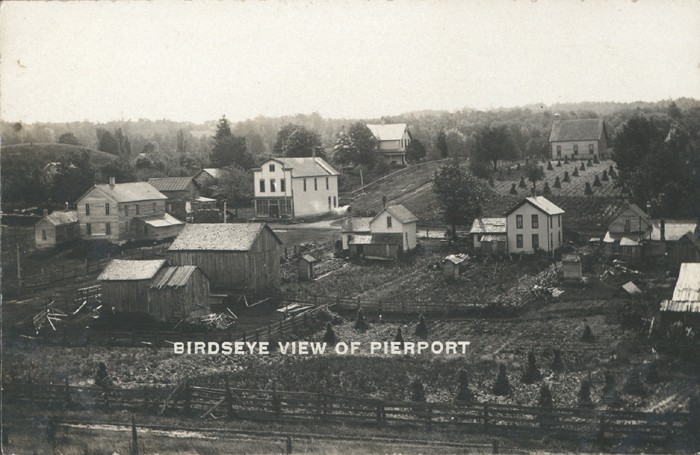 |
|
| Birdseye View of Pierport The C. W. Perry general store is the light colored building just left of center in the photo. Date unknown. |
|
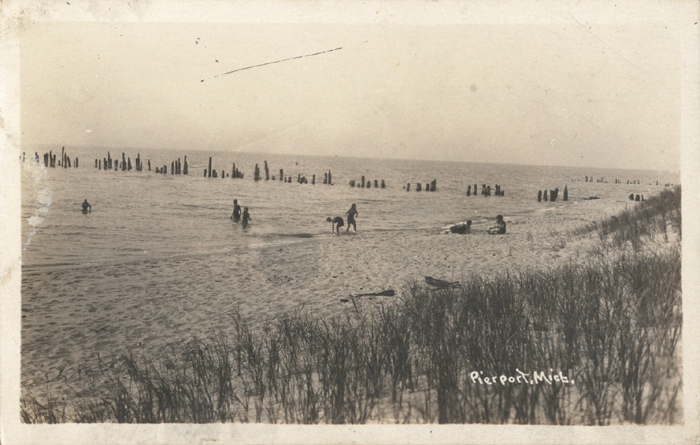 |
|
| The Beach at Pierport Note the remains of the pier just behind the bathers and a second pier in the background on the right. These are the remains of Perry's pier and the Hopkins pier respectively. The DownturnIn the late 1880s, Pierport began to dry up. In 1887, typhoid fever hit Pierport, and many people died within a week of contracting the fever. By 1890, the land around Pierport was wearing out, the forests had dwindled, and the railway was no longer in operation. People left. In 1895 the only business still operating in Pierport was the Perry store. In 1898, the piers were no longer used. In 1933, the post office closed. |
|
